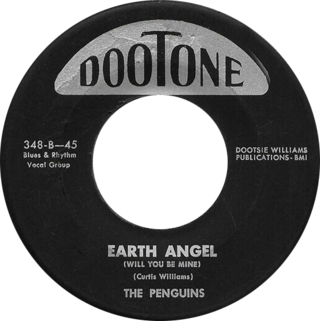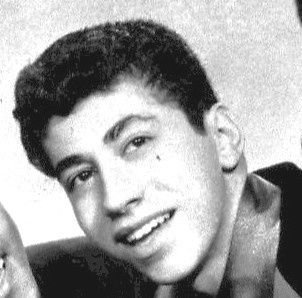The Penguins were an American doo-wop group from Los Angeles, California, that were active during the 1950s and early 1960s. They are known for their 1954 hit song, "Earth Angel", which was one of the first rhythm and blues songs to cross over to the pop charts. The song would ultimately prove to be their only success. The song peaked at No. 8 on the US Billboard Best Sellers in Stores pop chart but had a three-week run at No. 1 on the R&B chart.

Doo-wop is a genre of rhythm and blues music that originated in African-American communities during the 1940s, mainly in the large cities of the United States, including New York, Philadelphia, Pittsburgh, Chicago, Baltimore, Newark, Detroit, Washington, D.C., and Los Angeles. It features vocal group harmony that carries an engaging melodic line to a simple beat with little or no instrumentation. Lyrics are simple, usually about love, sung by a lead vocal over background vocals, and often featuring, in the bridge, a melodramatically heartfelt recitative addressed to the beloved. Harmonic singing of nonsense syllables is a common characteristic of these songs. Gaining popularity in the 1950s, doo-wop was "artistically and commercially viable" until the early 1960s, but continued to influence performers in other genres.

Franklin Joseph Lymon was an American rock and roll/rhythm and blues singer and songwriter, best known as the boy soprano lead singer of the New York City-based early rock and roll doo-wop group The Teenagers. The group was composed of five boys, all in their early to mid-teens. The original lineup of the Teenagers, an integrated group, included three African-American members, Lymon, Jimmy Merchant, and Sherman Garnes; and two Puerto Rican members, Joe Negroni and Herman Santiago. The Teenagers' first single, 1956's "Why Do Fools Fall in Love", was also their biggest hit. After Lymon went solo in mid-1957, both his career and that of the Teenagers fell into decline. In 1968, Lymon was found dead at the age of 25 on the floor of his grandmother's bathroom from a heroin overdose. Lymon was posthumously inducted into the Rock and Roll Hall of Fame in 1993 as a member of the Teenagers. His life was dramatized in the 1998 film Why Do Fools Fall in Love.

Martha and the Vandellas were an American vocal girl group formed in Detroit in 1957. The group achieved fame in the 1960s with Motown.

The Moonglows were an American R&B group in the 1950s. Their song "Sincerely" went to number 1 on the Billboard R&B chart and number 20 on the Billboard Juke Box chart.

The Flamingos are an American doo-wop group formed in Chicago in 1953. The band became popular in mid-to-late 1950s and are known for their 1959 cover version of "I Only Have Eyes for You". They have since been hailed as one of the finest and most influential vocal groups in pop and doo wop music history. In 2001, the band was inducted into the Rock and Roll Hall of Fame.
The Orioles were an American R&B group of the late 1940s and early 1950s, one of the earliest such vocal groups who established the basic pattern for the doo-wop sound.

The Crows were an American R&B singing group formed in 1951 who achieved commercial success in the 1950s. The group's first single and only hit, "Gee", released in June 1953, has been credited with being the first rock n’ roll hit by a rock and roll group. It peaked at position #14 and #2, respectively, on the Billboard magazine pop and rhythm-and-blues charts in 1954. Although Gee fell into the Doo Wop genre, and "was the first 1950s doo-wop record to sell over one million records" in that genre, some consider it as the first of the "rock n' roll records".

"Earth Angel", occasionally referred to as "Earth Angel (Will You Be Mine)", is a song by American doo-wop group the Penguins. Produced by Dootsie Williams, it was released as their debut single in October 1954 on Dootone Records. The Penguins had formed the year prior and recorded the song as a demo in a garage in South Central Los Angeles. The song's origins lie in multiple different sources, among them songs by Jesse Belvin, Patti Page, and the Hollywood Flames. Its authorship was the subject of a bitter legal dispute with Williams in the years following its release.

Herman Santiago is a Puerto Rican rock and roll pioneer and songwriter who was previously a member of the vocal group Frankie Lymon and the Teenagers. He (disputedly) co-wrote the group's iconic hit "Why Do Fools Fall in Love".
Rama Records was a record label founded by George Goldner in 1953 in New York City. It recorded doo-wop groups such as The Crows and The Harptones.
George Goldner was an American record label owner, record producer and promoter who played an important role in establishing the popularity of rock and roll in the 1950s, by recording and promoting many groups and records that appealed to young people across racial boundaries. Among the acts he discovered were the Crows, Frankie Lymon and the Teenagers, and Little Anthony and the Imperials.

"Sh-Boom" is an early doo-wop song by the R&B vocal group The Chords. It was written by James Keyes, Claude Feaster, Carl Feaster, Floyd F. McRae, and William Edwards, members of The Chords, and published in 1954. It is sometimes considered the first doo-wop or rock 'n' roll record to reach the top ten on the pop charts, as it was a top-10 hit that year for both the Chords and The Crew-Cuts. In 2004, it was ranked No. 215 on Rolling Stone's "Top 500 Best Songs of All Time".
"Heart and Soul" is a popular song composed by Hoagy Carmichael with lyrics by Frank Loesser. It charted with different artists between 1938 and 1961. A simplified version is a popular piano duet.

"Why Do Fools Fall in Love" is a song by American rock and roll band Frankie Lymon & the Teenagers that was released on January 10, 1956. It reached No. 1 on the R&B chart, No. 6 on Billboard's Pop Singles chart, and No. 1 on the UK Singles Chart in July. Many renditions of the song by other artists have also been hit records in the U.S., including versions by the Diamonds, the Beach Boys, and Diana Ross.

Joe Negroni was an American singer of Puerto Rican descent. He was a rock and roll pioneer and founding member of the rock and roll group Frankie Lymon and the Teenagers.

The Chords were an American doo-wop vocal group formed in 1951 in The Bronx, New York, known for their 1954 hit "Sh-Boom", which they wrote. It is the only song they created that reached mainstream popularity.
The Valentines were one of the most highly regarded American doo-wop groups from the mid-1950s.
"Little Darlin'" is a popular Top 40 song, made famous by the Diamonds.
"It's Too Soon to Know" is an American doo-wop ballad by Deborah Chessler (1923–2012), performed first by The Orioles. It was number one on the American Rhythm and blues charts in November 1948. It is considered by some to be the first "rock and roll" song, and described by others as "the first rhythm and blues vocal group harmony recording".












